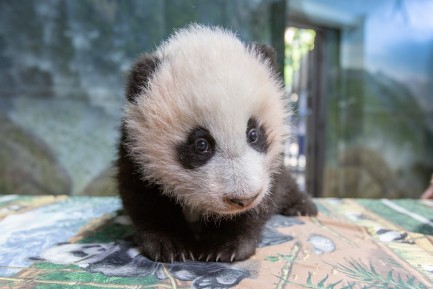Giant panda cub Xiao Qi Ji was born at Smithsonian’s National Zoo Aug. 21, 2020.
Smithsonian’s National Zoo and Conservation Biology Institute Extends Giant Panda Agreement

Giant pandas Mei Xiang (left) and Tian Tian (right) will continue to live at the Zoo through the end of 2023 per a three-year agreement extension signed by Smithsonian’s National Zoo and Conservation Biology Institute and China Wildlife and Conservation Association (CWCA). Photo: Ann Batdorf, Smithsonian’s National Zoo
Giant pandas, icons and ambassadors for the efforts to save the species in Washington, D.C., since 1972, will continue to live at the Smithsonian’s National Zoo through the end of 2023. The three-year agreement extension signed by Smithsonian’s National Zoo and Conservation Biology Institute and China Wildlife and Conservation Association (CWCA), is effective through Dec. 7, 2023.
The terms of the agreement extension are similar to previous agreements. Cub Xiao Qi Ji (SHIAU-chi-ji), born at the Zoo Aug. 21, female giant panda Mei Xiang (may-SHONG), age 22, and male giant panda Tian Tian (tee-YEN tee-YEN), age 23, will go to China at the end of the three-year agreement extension.
“Our long-standing collaboration with Chinese colleagues to study, care for and save the giant panda will now pass the half-century mark,” said Steve Monfort, John and Adrienne Mars Director of the Smithsonian’s National Zoo and Conservation Biology Institute. “Through the power of science and cooperation, and with the support of the public and benefactors like David Rubenstein, our work on behalf of this beloved bear species continues. Along with millions of Americans, I look forward to the next three years, watching Xiao Qi Ji grow and making further strides in conservation and in our understanding of giant pandas.”
David M. Rubenstein, co-founder and co-CEO of The Carlyle Group and member of the Smithsonian Board of Regents, has pledged a $3 million gift to the Zoo and Conservation Biology Institute, funding its giant panda research and conservation program through the end of 2023. Rubenstein has donated a total of $12 million in support of the Zoo’s giant panda conservation program. The gift will support conservation efforts in China, including research on restoring giant panda habitat, monitoring wildlife diseases, assessing impacts of climate change and supporting more conservation capacity-building programs, upgrades to the giant panda habitat and exhibit at the Zoo, care for the pandas living at the Zoo and public education about the species and conservation.
“Giant pandas are an incredible species that still need our help,” Rubenstein said. “Supporting the Zoo’s giant panda conservation program is very rewarding.”
Mei Xiang, which means “beautiful fragrance,” and Tian Tian, meaning “more and more,” have lived at the Zoo since Dec. 6, 2000. Both pandas were born at the China Conservation and Research Center for the Giant Panda. Much of what Zoo animal care staff and scientists know about giant panda biology, behavior and reproduction—knowledge shared with other institutions caring for and breeding this vulnerable species—is a result of caring for and studying Mei Xiang and Tian Tian over two decades.
Mei Xiang has given birth to four surviving cubs, all sired by Tian Tian: Tai Shan (tie-SHON), Bao Bao (BOW BOW), Bei Bei (BAY BAY) and Xiao Qi Ji. Tai Shan was born July 9, 2005, and moved to China in February 2010. Bao Bao was born Aug. 23, 2013, and moved to China in February 2017. Bei Bei was born Aug. 22, 2015, and moved to China in November 2019. With the birth of Xiao Qi Ji Aug. 21, Mei Xiang became the oldest giant panda to give birth in North America.
The Smithsonian’s National Zoo and Conservation Biology Institute is a key player in giant panda conservation. Ever since these charismatic bears arrived at the Zoo in 1972, animal care staff and scientists have studied giant panda biology, behavior, breeding, reproduction and disease. The Zoo’s experts are also leading ecology studies in giant pandas’ native habitat. The Zoo’s giant panda team works closely with colleagues in China to advance conservation efforts for giant pandas in human care and in the wild.
It is estimated that there are over 1,800 giant pandas in the wild in China. These individuals live in scattered populations in central China, mostly in Sichuan Province, but also in Gansu and Shaanxi provinces. Chinese scientists are working to reintroduce giant pandas to the wild. The estimated lifespan is about 15–20 years for wild pandas and about 30 years for those in human care.
As a public health precaution due to COVID-19, the Zoo is currently closed. The Zoo will continue to provide updates on the cub via its website, on social media using the hashtags #PandaStory and #PandaCubdates and in its Giant Panda e-newsletter. Giant panda fans can see the cub, mother Mei Xiang and father Tian Tian via the Giant Panda Cam on the Zoo’s website. It is one of five live animal webcams hosted on the Zoo’s website.
# # #
SI-348-2020

